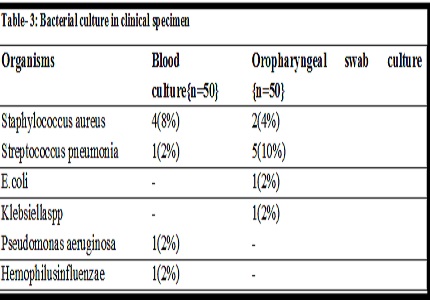Microbiological profile in community acquired pneumonia in children
Abstract
Introduction: Community acquired pneumonia (CAP) refers to an infection of the lung by a variety of micro-organisms acquired outside the hospital setting.
Methods and Material: It was prospective study conducted at department of Pediatrics of a tertiary care hospital of North India for a period of 12 months on children with community acquired pneumonia admitted in ward and emergency. Total 50 cases were enrolled in the study as recent WHO guidelines of community acquired pneumonia. Samples oforopharyngeal swab and blood for culture and sensitivity were collected with standard precautions from every child and sent for bacteriological lab within 30 minute of collection.
Results: Outof 50 cases 36 (72%) were diagnosed as pneumonia and 14 (28%) were as severe pneumonia. On blood culture only 7 (14%) had positive growth and on oropharyngeal swab culture 9(18%) had growth. Staphylococcus aureus and Streptococcus pneumonia were predominant organism on blood culture and oropharyngeal swab culture respectively.
Conclusion: The overall rate of identification of bacterial etiologyof CAP was low. Streptococcuspneumonae and Staphylococcus aureus predominate in oropharyngeal swab culture and blood culture respectively.
Downloads
References
2. Rudan I, Tomaskovic L, Boschi-Pinto C, Campbell H; WHO Child Health Epidemiology Reference Group. Global estimate of the incidence of clinical pneumonia among children under five years of age. Bull World Health Organ. 2004 Dec;82(12):895-903. Epub 2005 Jan 5.
3. pneumonia among children under five years of age. Bull World Health Organ 2004; 82: 895-903. [PubMed]
4. DublishS.,Singh V. Pneumonia. In: Piyush G., PSN M,SiddhartR,Rakesh L. PG Text book of pediatrics.1st ed. New Delhi:Jaypee Brothers;2015. vol2. p 1720-28.
5. Gilani Z, Kwong YD, Levine OS, Deloria-Knoll M, Scott JA, O'Brien KL, Feikin DR. A literature review and survey of childhoodpneumoniaetiologystudies: 2000-2010. Clin InfectDis. 2012 Apr;54 Suppl2:S102-8. doi: 10.1093/cid/cir1053. [PubMed]
6. WHO. (2014) Revised WHO classification and treatment of childhood pneumonia at health facilities. Evidence Summaries, WHO 2014. Available at: http://apps.who.int/iris/ bitstream/10665/137319/1/9789241507813_eng.pdf (accessed 23 december 2017).
7. Shekhawat YS, Sharma P, Singh A, Payal V et al. Bacteriological and clinical profile of community acquired pneumonia in hospitalised children with associated co-morbidity in tertiary care centre of Western Rajasthan, India. Int J Contemppediatr. 2016 ;3(4):1380-1384. ijcp20163682. doi: http//dx.doi.org/10.18203/2349-3291.
8. Agweyu A, Kibore M, Digolo L. Prevalence and correlates of treatment failure among Kenyan children hospitalized with severe community-acquired pneumonia: a prospective study of the clinical effectiveness of WHO pneumonia case management guidelines.2014;19(11):1310-1320. doi:10.1111/tmi.12368.
9. Mathew J L, Singhi S, Ray P et al. Etiology of community acquired pneumonia among children in India: prospective, cohort study. PGIMER Chandigarh, India. J Glob Health. 2015;5(2):050418. Doi: 10.7189.
10. Das A, Patgiri SJ, Saikia L, Dowerah P, Nath R et al. Bacterial pathogens associated with community-acquired pneumonia in children aged below five years. Indian pediatrics, vol 53; 2016: 225-227. [PubMed]
11. N euman MI, Hall M, Lipsett SC, Hersh AL, Williams DJ, Gerber JS, Brogan TV, Blaschke AJ, Grijalva CG, Parikh K, Ambroggio L, Shah SS; Pediatric Research in Inpatient Settings Network. Utilityof Blood Culture Among Children Hospitalized with Community-Acquired Pneumonia. Pediatrics.2017 Sep;140(3). pii: e20171013. doi: 10.1542/peds.2017-1013. Epub2017 Aug 23. [PubMed]
12. Saha SK, Rikitomi N, Ruhulamin M et al Antimicrobial Resistance and Serotype Distribution of Streptococcus pneumoniaeStrains Causing Childhood Infections in Bangladesh, 1993 to 1997.J Clin Microbiol. 1999 Mar; 37(3): 798–800.
13. Hoban DJ, Biedenbach DJ, Mutnick AH, Jones RN. Pathogen of occurrence and susceptibilitypatternsassociated with pneumonia in hospitalizedpatients in North America: results of the SENTRYAntimicrobialSurveillance Study (2000). Diagn MicrobiolInfectDis. 2003 Apr;45(4):279-85. [PubMed]
14. Nag VL, Ayyagari A, Vnkatesh V, Ghar M, Yadav V, Prasad KN et al. Drug resistant Haemophilus influenza from respiratory tract infection in a tertiary care hospital in North India. Indian J chest dis allied sci 2001;43:13-17.
15. Kilabuko JH, Nakai S. Effects of cooking fuels on acute respiratory infections in children in Tanzania. Int J Environ Res Public Health. 2007 Dec;4(4):283-8.
16. Savitha MR, Nandeeshwara SB, Pradeep Kumar MJ, ul-Haque F, Raju CK. Modifiablerisk factors for acutelowerrespiratory tract infections. Indian J Pediatr.2007 May;74(5):477-82. [PubMed]

Copyright (c) 2018 Author (s). Published by Siddharth Health Research and Social Welfare Society

This work is licensed under a Creative Commons Attribution 4.0 International License.


 OAI - Open Archives Initiative
OAI - Open Archives Initiative


